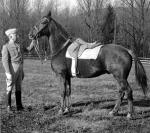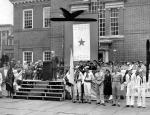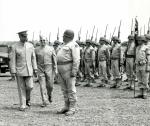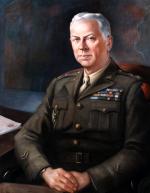![header=[Marker Text] body=[Formed February 9, 1796, from Washington County. Named for Gen. Nathanael Greene. Waynesburg, the county seat named for Gen. Anthony Wayne, was incorporated in 1916. Site of Waynesburg College, founded in 1849. Near Ten Mile is birthplace of Gov. Edward Martin.] sign](http://explorepahistory.com/kora/files/1/10/1-A-2E8-139-ExplorePAHistory-a0k4s7-a_450.jpg)
Mouse over for marker text
Name:
Greene County [Governor Edward Martin] World War II
Region:
Laurel Highlands/Southern Alleghenies
County:
Greene
Marker Location:
County Courthouse, High Street, Waynesburg
Dedication Date:
May 3, 1982
Behind the Marker
"Right now nothing matters but winning the war, because if we do not win it, nothing else matters," declared Governor Edward Martin during his inaugural speech as governor in 1943. Spoken like a true soldier! And indeed, Martin, at age sixty-three, had spent much of his adult life in the service of both his state and his country.
Born in Greene County in 1879, young Edward Martin was attending local Waynesburg College when war with Spain broke out in 1898. Eager to fight, he joined the 10th Pennsylvania Infantry, went off to the Philippines with the regiment, and came back a sergeant. After completing his college degree, Martin rejoined the state national guard. He then passed his bar exam and began practicing law in Waynesburg, married, started a family, and became active in local politics.
When the Pennsylvania National Guard's 28th Division was mobilized during World War I, Martin went with it to France and came home a true war hero, having survived a direct shell hit on his headquarters, friendly fire, and a German gas attack, from which it took him two years to recover.
After the war, Martin returned to his law practice and in the decade that followed amassed a fortune in banking, oil, and gas. By 1922, he was also a brigadier general with the 28th Division, then won election to state auditor general (1925-1929) and state treasurer (1929-1933). Martin became state adjutant general in 1939, appointed by Governor Arthur James, with a concomitant promotion to Major General in command of the
Governor Arthur James, with a concomitant promotion to Major General in command of the  28th Division. When the division was federalized, Martin was retired by the army in April 1942 because of his age.
28th Division. When the division was federalized, Martin was retired by the army in April 1942 because of his age.
Martin was still in the military when state Republican leaders approached him to run for governor of Pennsylvania. Before making any decision, he called General George Marshall, a close friend, who told him that "Pennsylvania's diversity of industry and its seventy posts and stations of the service make it the most important state of the Union. If you think you can be elected I hope you accept …." Later that year, the Republican party selected the retired general as its candidate for governor. A self-made man, war hero, and veteran politician, Martin was an ideal choice for the time. He beat his Democratic rival F. Clair Ross by 217,000 votes and took office in January 1943.
General George Marshall, a close friend, who told him that "Pennsylvania's diversity of industry and its seventy posts and stations of the service make it the most important state of the Union. If you think you can be elected I hope you accept …." Later that year, the Republican party selected the retired general as its candidate for governor. A self-made man, war hero, and veteran politician, Martin was an ideal choice for the time. He beat his Democratic rival F. Clair Ross by 217,000 votes and took office in January 1943.
The war had pulled Pennsylvania's economy out of the Great Depression, and the Commonwealth out of debt. Governor James had left Martin's administration a surplus of more than $18 million. Rising production and employment meant increased tax revenues, so Martin was able to reduce taxes to help all Pennsylvanians. During the war, Pennsylvania also authorized absentee ballots for her soldiers. Aided by a Republican-controlled State House, Martin effectively guided the Commonwealth through the remainder of the world conflict and led it through demobilization of the armed forces and the reconversion to a peacetime economy.
Realizing that chaos would result from a lack of planning, Martin in 1943 had pushed for the establishment of a Post-war Planning Commission to ease soldiers back into civilian life. As a result of this commission and other legislation, Martin, acting the soldier he always was-he preferred to be addressed as "General" even in civilian life-ensured that Pennsylvanians returning home would be well cared for. The legislature liberalized unemployment laws to include men covered at the time of their entry into military service. Martin also created a State Veterans" Administration to expedite claims for hospitalization and compensation. In tandem with this commission, local draft boards opened Veterans Information Centers. In more than 100 communities, Veterans" Advisory Committees were set up to help returning soldiers adapt to civilian life. Combined with vocational rehabilitation services and increased educational opportunities at state teachers" colleges, all of this legislation served as a model for other states to follow.
Martin also authorized increased funding for public schools, the consolidation of smaller schools into larger, more efficient units, the creation of the Pennsylvania Historical and Museum Commission, an expanded highway development program, increased funds for airports, a clean streams initiative, enlargement of state game lands, modernization of state penal and correctional facilities, vocational training for the blind and visually handicapped, and the encouragement of home rule for local governments.
While still governor, Martin in 1946 ran for the United States Senate and easily defeated his Democratic opponent by 608,000 votes, the last of fifteen successful races for office during his political career. (He never lost a race.) In the Senate from 1947-1958, Martin was an outspoken anti-Communist and focused his attention on fiscal responsibility, warning his colleagues that the country should maintain a balanced budget. Martin retired in 1958 to Washington, Pennsylvania, where he served as an oil and gas company president, wrote his autobiography and a history of the 28th Division, and remained active in veterans" affairs. He died in 1967 and was buried in Waynesburg.
Born in Greene County in 1879, young Edward Martin was attending local Waynesburg College when war with Spain broke out in 1898. Eager to fight, he joined the 10th Pennsylvania Infantry, went off to the Philippines with the regiment, and came back a sergeant. After completing his college degree, Martin rejoined the state national guard. He then passed his bar exam and began practicing law in Waynesburg, married, started a family, and became active in local politics.
When the Pennsylvania National Guard's 28th Division was mobilized during World War I, Martin went with it to France and came home a true war hero, having survived a direct shell hit on his headquarters, friendly fire, and a German gas attack, from which it took him two years to recover.
After the war, Martin returned to his law practice and in the decade that followed amassed a fortune in banking, oil, and gas. By 1922, he was also a brigadier general with the 28th Division, then won election to state auditor general (1925-1929) and state treasurer (1929-1933). Martin became state adjutant general in 1939, appointed by
Martin was still in the military when state Republican leaders approached him to run for governor of Pennsylvania. Before making any decision, he called
The war had pulled Pennsylvania's economy out of the Great Depression, and the Commonwealth out of debt. Governor James had left Martin's administration a surplus of more than $18 million. Rising production and employment meant increased tax revenues, so Martin was able to reduce taxes to help all Pennsylvanians. During the war, Pennsylvania also authorized absentee ballots for her soldiers. Aided by a Republican-controlled State House, Martin effectively guided the Commonwealth through the remainder of the world conflict and led it through demobilization of the armed forces and the reconversion to a peacetime economy.
Realizing that chaos would result from a lack of planning, Martin in 1943 had pushed for the establishment of a Post-war Planning Commission to ease soldiers back into civilian life. As a result of this commission and other legislation, Martin, acting the soldier he always was-he preferred to be addressed as "General" even in civilian life-ensured that Pennsylvanians returning home would be well cared for. The legislature liberalized unemployment laws to include men covered at the time of their entry into military service. Martin also created a State Veterans" Administration to expedite claims for hospitalization and compensation. In tandem with this commission, local draft boards opened Veterans Information Centers. In more than 100 communities, Veterans" Advisory Committees were set up to help returning soldiers adapt to civilian life. Combined with vocational rehabilitation services and increased educational opportunities at state teachers" colleges, all of this legislation served as a model for other states to follow.
Martin also authorized increased funding for public schools, the consolidation of smaller schools into larger, more efficient units, the creation of the Pennsylvania Historical and Museum Commission, an expanded highway development program, increased funds for airports, a clean streams initiative, enlargement of state game lands, modernization of state penal and correctional facilities, vocational training for the blind and visually handicapped, and the encouragement of home rule for local governments.
While still governor, Martin in 1946 ran for the United States Senate and easily defeated his Democratic opponent by 608,000 votes, the last of fifteen successful races for office during his political career. (He never lost a race.) In the Senate from 1947-1958, Martin was an outspoken anti-Communist and focused his attention on fiscal responsibility, warning his colleagues that the country should maintain a balanced budget. Martin retired in 1958 to Washington, Pennsylvania, where he served as an oil and gas company president, wrote his autobiography and a history of the 28th Division, and remained active in veterans" affairs. He died in 1967 and was buried in Waynesburg.








